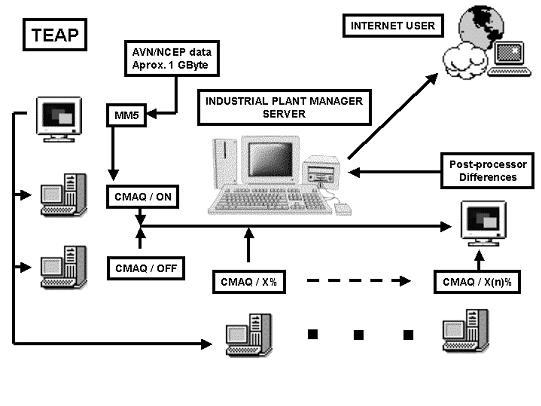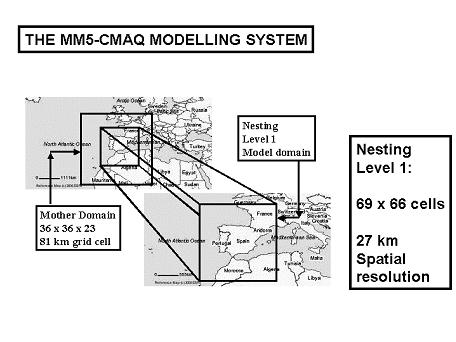
 |
||
| Scientists' Contributions | ||
ENVIRONMENTAL SOFTWARE AND MODELLING GROUP CONTRIBUTION TO EURASAP
COMPUTER SCIENCE SCHOOL – TECHNICAL UNIVERSITY OF MADRID
In this contribution we will describe our activities in the field of Air Quality Modelling Systems for EURASP newsletter.
The Environmental Software and Modelling Group is a research group located at the Computer Science School of the Technical University of Madrid (UPM). The group was founded by Prof. Roberto San José in 1992. The group is focused mainly on air quality modelling and also measuring (first stage).
Professor Roberto San José is a doctor in Physics by the University of Valladolid (Spain) in 1983. His Ph. D. was titled: “Automatization of a 100 m tower and obtaining the unstable turbulent atmospheric boundary layer parameters”. During the 80’s professor San José was teaching numerical analysis and physics at the Architecture of the University of Valladolid. Unitil 1988, Dr. San José worked on spectral analysis of meteorological measurements in towers applying the Similarity Theory and Monin-Obukhov theory. Also he started to work with deposition velocity modelling and measuring. In 1989 Dr. San José obtained a grant for the Max-Planck Meteorology Institute located at Hamburg (Germany) to work on mesoscale meteorological models and to apply the subgrid parameterisations into the early versions of air quality meteorological mesoscale models. In 1990 he also accepted a position at the IBM-Bergen Environmental Sciences and Solutions Centre in Bergen (Norway) as a guest scientist. He worked in mesoscale air quality modelling systems. He participated together with the University of Karlsruhe (Germany) and Los Alamos National Laboratory (USA) in the Olympics Project in Barcelona 92 by modelling the photochemical expected smog during the Olympic Games period.
In 1992, Dr. San José started at the Computer Science School of the Technical University of Madrid (Spain). He was principal investigator on several EU and national projects such as SREMP, EXAMINE and MEDFLUX in the Environmental Programme of the EU projects. These projects focused on the investigation of the deposition processes in Mediterranean ecosystems for several different pollutants. We measured several pollutants such as O3, NOx, SO2 and NH3 by using fast response instrumentation (eddy correlation; NH· was measured by using liquid Denuder analysers from ECN) and correlate these measurements for setting the proper parameters for the deposition velocity modelling systems. In 1996 the group started to contribute to projects in the IST programme of the EU research projects – in addition to the environmental projects already mentioned -. The group contributed in the EMMA, EQUAL, APNEE and today in the APNEE-TU project. During this project the group also contributed to DECAIR (EU-CEO programme) and OSCAR project (today’s contribution into the City of Tomorrow programme).
As a result of these contribution - and several other to national environmental programmes in addition private contracts with companies particularly in the area of environmental impact analysis and also to EUREKA projects (UPM is coordinating the TEAP project which involves companies from Spain and parties and companies from Lithuania) - the group has gained a high level of experience on air quality monitoring and modelling analysis.
The research group has organized along the last 10 years at the UPM, several conferences and workshops in the EUROTRAC-2 project (BIATEX, GLOREAM), Urban Air Quality Conference in 1999 and Wessex Institute Conferences (on environmental measuring and modelling processes investigation).
MAIN RESEARCH FINDINGS
The group has contributed significantly to perform measuring experiments for deposition modelling in our areas. These modelling findings were incorporated into the mesoscale air quality modelling systems. The scientific approach used in SREMP, EXAMINE and MEDFLUX was to quantify the eddy correlation pollutant fluxes (measured in the field in our field experiments) (average of covariances between concentration and vertical wind component fluctuations) and the corresponding modelling comparison (Wesely et al. 1989; Erisman et al. 1994; etc.). The field campaigns were carried out with several research groups in EU such as University of Aveiro (portugal), Ispra (JRC), ECN, RIVM, (The Netherlands), University of Edimburgh, Max-Planck Institute of Chemistry (Germany), etc.
The modelling research was initiated at the end of the 80’s by Dr. San José in the max-Plank Institute of Meteorology in Hamburg (Germany) and continued in the IBM-Bergen Environmental Sciences and Solution Centre until 1992. In 1994 after running the MEMO model in the Laboratory and applied it over the Madrid domain, we incorporated the chemical mechanism CBM-IV by using the SMVGEAR technique from Jacobson and Turco (University of Los Angeles, USA) in on-line mode in the MEMO code. This created a photochemical mesoscale model called ANA (Atmospheric Numerical mesoscale pollution model for urban and regional Areas). This was a limited area model without precipitation but with the chemistry included as part of the numerical mesoscale meteorological model MEMO (adapted to several pollutants).
In 1995 we developed the so-called EMIMA model which an emission inventory processor which uses mainly a bottom-up approach and it created emission data for the system MEMO-SMVGEAR (ANA). On that time we were contributing to EUROTRAC-1 (BIATEX) to provide the results of the SREMP, EXAMINE and MEDFLUX EU projects. In EUROTRAC-2, the group contributed to GLOREAM, SATURN and GENEMIS subprojects. In EMMA EU-IST project we developed an application to run the system in operational mode by using vertical meteorological soundings and air quality monitoring network information for the Madrid domain. The system was installed in Madrid city and Madrid Community Environmental offices. The system architecture was adapted to the computer power characteristics to allow the system to run in overnight mode to obtain 72 hours forecast information under daily operational basis. The system required to be operated by an experienced operator (trained at the Laboratory at UPM). In parallel to these activities we developed a software interface to allow an external operator to operate with such a complex system. This application was developed in Tcl/Tk and is part of the full system to be installed at the user’s site.
In 1997 we started to develop an automatic Internet application of the ANA system (OPANA) which uses Internet meteorological information as boundary and initial conditions for MEMO downloaded from the AVN global meteorological model (NCEP, USA). The system was running in automatic model under daily basis and the output information was provided over the Internet in the context of the EQUAL-EU-IST project. The interface over the Internet used Html/CGI tools and allowed a geographical location from the Internet user to get the time series and the surface maps in a real-time mode.
In APNEE project, the group has contributed by extending the OPANA applications to several different user sites such as Andalusia and Canary Islands and also has connected the air quality modelling systems to multimedia mobile technologies applications such as SMS, MMS, WAP and PDA tools by incorporating the so-called warning concept in a way that the user is adviced to take different actions based on the air quality forecasts for the next 72 hours in the area where the user lives.
The group has contributed also to the EUREKA project named TEAP (A tool to evaluate the air quality impact of industrial plants). This tool focuses on the use of OPANA and MM5-CMAQ for evaluating the air quality impact of industrial emissions in real-time. The system architecture requires a cluster of computer platforms which are used to run in 12-16 hours of CPU/real-time which perform the following tasks:
- MM5 run over 120 hours starting 24 hours in the past. Nesting approach focusing over the area where the industrial plant is located.
- CMAQ (OFF) run over 120 hours starting 24 hours in the past. Nesting approach focusing over the area where the industrial plant is located.
- ON-CMAQ run over 120 hours starting 24 hours in the past which is identical to the 2) run but including the industrial emissions. Nesting approach focusing over the area where the industrial plant is located.
- And a simulation for each emission emission scenario up to N.
The system includes a post-processing analysis system which analyses the differences between ON and OFF scenarios and also all other emission reduction scenarios included. The system allows to know in detail the impact of the industrial plant and also the impact of every different scenario approach. Figure 1 shows a scheme of the application of the MM5-CMAQ modelling system to analyze real-time emission industrial impacts with several different emission scenario patterns.
Since 2000, the groups started to group with additional modelling systems such as CAMx, UAM-V, CALMET, CALPUFF, ETA, etc. In fact MM5 model is running in the Lab. since 1999 and it is running in operational mode since 2001. The group was running also in operational mode del Regional Spectral Model (RSM, NCEP, USA) over the Internet since 2000. Also, since 2000, the group has been working with the CMAQ (Community Multiscale Air Quality Modelling System, EPA, U.S.) model connected to the MM5 mesoscale meteorological model for the meteorological initial data sets.
 Figure 1. - Architecture of the use of MM5-CMAQ as a tool to evaluate the air quality impact of industrial emissions by using different emission scenario patterns. |
The system MM5-CMAQ requires much more computer power although for a national level and using 1-2 nesting levels the system can be run over a platform of two PC-LINUX computers connected over the Internet to get in automatic mode the AVN global data sets for initialising and provide the boundary conditions for the meteorological part.
Several academic experiments have been carried out with the MM5-CMAQ modelling system such as the so-called “process analysis”. The process analysis provides detailed information of all the chemical processes involved in the atmospheric modelling simulation. These processes includes information related to the impact of advection (horizontal and vertical), diffusion (vertical and horizontal), chemistry, deposition, emissions, etc. on the final concentration. The modular approach of CMAQ and the robustness of the tool (together with the MM5 module) assures the maximum quality on the performance of the modelling system. Figure 2 shows an example of the application of the MM5-CMAQ modelling system with one nesting level over the Iberian Peninsula.
 Figure 2. - MM5-CMAQ modelling system architecture over the Iberian Peninsula. |
In 2000 the group – as part of his contribution to GENEMIS – developed the EMIMO model which is a software tool which allows to calculate emission data (biogenic and anthropogenic) for being used in air quality modelling systems (OPANA and MM5-CMAQ). EMIMO tool uses a top-down approach which makes use of global and continental emission, population and GIS data sets such as GEIA, EMEP, EDGAR, CIESIN, DCW, USGS land use data, GTOPO, etc. for obtaing the best approach of high spatial and temporal resolution of emission data.
The system uses “training areas” provided by UK Environmental Ministry (1 km emission inventory, source disaggregated) and IER (EUROTRAC-2, GENEMIS coordinator) emission tool for Spain. A combination of all above data sets and the use of multilinear regression analysis generates appropiate emission data for air quality modelling systems. It is adviced to incorporate additional industrial emission source points and some local information to improve the quality of the data ingested into the AQM’s models.
We are currently working on street level modelling as part of our contribution to OSCAR project. We are working with MIMO model (University of Karlsruhe (Germany) and Laboratory of Heat Transfer and Environmental Engineering in the Aristotle University in Greece) as part of our research to incorporate the MIMO model as a nesting approach of MM5-CMAQ modelling system. In addition to this task, we are working on creating a data base of model results (including MIMO) with Street and Street Box models.
For detailed information and on-line modelling data, please visit: http://artico.lma.fi.upm.es
| Madrid, 1, April, 2003 Roberto San José Director / Environmental Software and modelling Group Computer Science School – Technical University of Madrid (Spain) | Back to the top |
 |
||
| Scientists' Contributions | ||